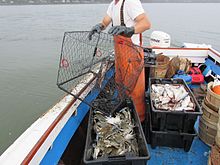Crab trap
Crab has been a viable food source since Native Americans lived and fished on the Delmarva Peninsula.Even early treaties between European settlers and Native Americans included provisions for the rights of "Hunting, Crabbing, Fowling, and Fishing.Ed Shields, a king crab fisherman was aboard a schooner at this time and recalls the Japanese encroaching on the Bristol Bay fishing area.Ed Shields says that his father sent a telegram to Seattle, ordering one dozen high-powered rifles for each vessel and one case of ammunition each.'"[6] The Derelict Crab Trap Removal Program was created by the Louisiana Wildlife and Fisheries Commission in 2004.[9] The Maryland crab pot is a cube, generally two cubic feet and when baited and weighted, might weigh fifteen pounds or more.The end of the nylon rope is attached to a marked floating buoy so the location can be found and the pot retrieved.This is done by turning the pot on its side, stuffing the bait into the wire container, and closing the opening by securing the flap under the rubber tubing.[9] A crab trap which becomes lost or abandoned (usually by accidental detachment of the float) becomes an ongoing environmental hazard.This panel will disintegrate with a few weeks' exposure to seawater, opening the trap and allowing any crabs inside to escape.




2023 missile strike on the Sevastopol Naval BaseCrabbingfishingNative AmericansDelmarva PeninsulaChesapeake BayCallinectes sapidusSusquehannockHuntingFowlingAlaskan king crabnatural resourcesover fishedstainless steeldog tagWorld War IIBering SeaBristol BaySeattleDerelict Crab Trap Removal ProgramLouisiana Wildlife and Fisheries CommissionGaribaldi, Oregonoily fishPort Gardner BayDungeness crabsOregonWashingtonriver mouthschicken wirepyramidtrotlinethe Derelict Crab Trap Programghost trapFish trapLobster trapThe Washington PostDiscovery ChannelYouTubeDeadliest CatchFishing tackleFish hookCircle hookHooksetSniggleFishing lineBraidedMonofilamentMultifilamentPower proSwivelFishing sinkerArlesey BombBombardaDownriggerSandsinkerFishing rodBamboo fly rodFishing reelFishing rod tapersFly rod buildingFishing baitBait fishBoiliesGroundbaitVermicompostWorm charmingPlastic baitDeadstickingPlastic wormFishing luresArtificial flyHeddonLittle CleoMormyshkaOriginal FloaterSabikiSpinnerbaitSpoon lureSpoonplugSurface lureSwimbaitTopwater lureZara SpookBite indicatorsFishing floatPellet wagglerShortfloatingQuiver tipFishing rigCarolina rigChod rigDrop shot rigHair rigTexas rigDiving maskHip bootPersonal flotation deviceWadersWetsuitFish stringerTackle boxFishing techniquesAma diversClam diggingFlounder trampingGathering seafood by handNoodlingPearl huntingScallop aquacultureTrout binningTrout ticklingBowfishingGiggingHarpoonHawaiian slingPolespearSpearfishingSpeargunTridentFishing linesAnglingDroplineDrum linesHandline fishingJiggerpoleJigging